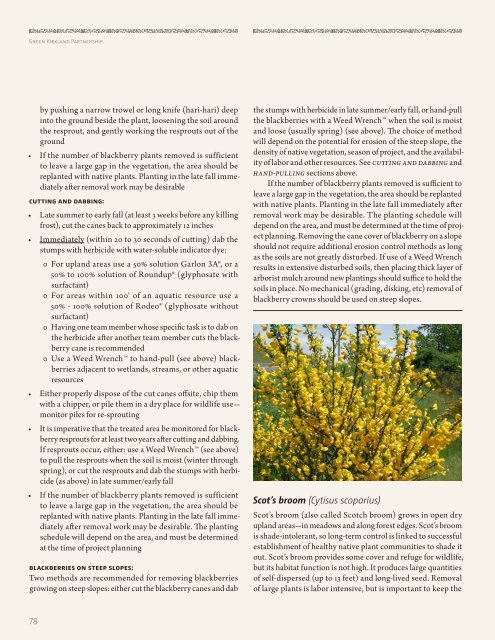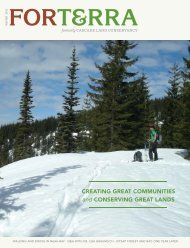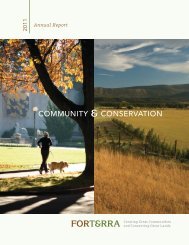Green <strong>Kirkland</strong> Partnershipby pushing a narrow trowel or long knife (hari-hari) deepinto the ground beside the plant, loosening the soil aroundthe resprout, and gently working the resprouts out <strong>of</strong> theground• If the number <strong>of</strong> blackberry plants removed is sufficientto leave a large gap in the vegetation, the area should bereplanted with native plants. <strong>Plan</strong>ting in the late fall immediatelyafter removal work may be desirableCutting and Dabbing:• Late summer to early fall (at least 3 weeks before any killingfrost), cut the canes back to approximately 12 inches• Immediately (within <strong>20</strong> to 30 seconds <strong>of</strong> cutting) dab thestumps with herbicide with water-soluble indicator dye:00 For upland areas use a 50% solution Garlon 3A®, or a50% to 100% solution <strong>of</strong> Roundup® (glyphosate withsurfactant)00 For areas within 100' <strong>of</strong> an aquatic resource use a50% - 100% solution <strong>of</strong> Rodeo® (glyphosate withoutsurfactant)00 Having one team member whose specific task is to dab onthe herbicide after another team member cuts the blackberrycane is recommended00 Use a Weed Wrench to hand-pull (see above) blackberriesadjacent to wetlands, streams, or other aquaticresources• Either properly dispose <strong>of</strong> the cut canes <strong>of</strong>fsite, chip themwith a chipper, or pile them in a dry place for wildlife use—monitor piles for re-sprouting• It is imperative that the treated area be monitored for blackberryresprouts for at least two <strong>year</strong>s after cutting and dabbing.If resprouts occur, either: use a Weed Wrench (see above)to pull the resprouts when the soil is moist (winter throughspring), or cut the resprouts and dab the stumps with herbicide(as above) in late summer/early fall• If the number <strong>of</strong> blackberry plants removed is sufficientto leave a large gap in the vegetation, the area should bereplanted with native plants. <strong>Plan</strong>ting in the late fall immediatelyafter removal work may be desirable. The plantingschedule will depend on the area, and must be determinedat the time <strong>of</strong> project planningBlackberries on steep slopes:Two methods are recommended for removing blackberriesgrowing on steep slopes: either cut the blackberry canes and dabthe stumps with herbicide in late summer/early fall, or hand-pullthe blackberries with a Weed Wrench when the soil is moistand loose (usually spring) (see above). The choice <strong>of</strong> methodwill depend on the potential for erosion <strong>of</strong> the steep slope, thedensity <strong>of</strong> native vegetation, season <strong>of</strong> project, and the availability<strong>of</strong> labor and other resources. See Cutting and Dabbing andHand-pulling sections above.If the number <strong>of</strong> blackberry plants removed is sufficient toleave a large gap in the vegetation, the area should be replantedwith native plants. <strong>Plan</strong>ting in the late fall immediately afterremoval work may be desirable. The planting schedule willdepend on the area, and must be determined at the time <strong>of</strong> projectplanning. Removing the cane cover <strong>of</strong> blackberry on a slopeshould not require additional erosion control methods as longas the soils are not greatly disturbed. If use <strong>of</strong> a Weed Wrenchresults in extensive disturbed soils, then placing thick layer <strong>of</strong>arborist mulch around new plantings should suffice to hold thesoils in place. No mechanical (grading, disking, etc) removal <strong>of</strong>blackberry crowns should be used on steep slopes.Scot’s broom (Cytisus scoparius)Scot’s broom (also called Scotch broom) grows in open dryupland areas—in meadows and along forest edges. Scot’s broomis shade-intolerant, so long-term control is linked to successfulestablishment <strong>of</strong> healthy native plant communities to shade itout. Scot’s broom provides some cover and refuge for wildlife,but its habitat function is not high. It produces large quantities<strong>of</strong> self-dispersed (up to 13 feet) and long-lived seed. Removal<strong>of</strong> large plants is labor intensive, but is important to keep the78
<strong>20</strong>-Year <strong>Forest</strong> <strong>Restoration</strong> <strong>Plan</strong>population from expanding, and to reduce the spread and accumulation<strong>of</strong> seeds. Removal and control <strong>of</strong> younger plants iseasier because they can be hand-pulled or mowed.Hand-pulling:• When the soil is moist and loose, use a Weed Wrench tohand-pull entire plants and root systems. The Weed Wrenchis a marvelous tool which grabs the stem between two jawswhile providing great leverage for pulling out the entire rootsystem. It comes in several sizes depending on the diameter<strong>of</strong> the stem that you want to pull. Using the Weed Wrenchcauses minimal soil disturbance—especially as compared tostandard grubbing methods• Pulled plants can be chipped or piled for wildlife use• It is imperative that the area be regularly monitored for Scot’sbroom for several <strong>year</strong>s after pulling—expect resprouts andseedling emergence. New plants should be pulled as soonas they are large enough to grasp, but before they produceseeds. When the soil is moist, either: use a Weed Wrenchto pull the plants if they are large enough; or hand-pull thesmaller plants by pushing a narrow trowel or long knife (harihari)deep into the ground beside the plant, loosening thesoil around it, and gently working the entire plant out <strong>of</strong> theground• If the number <strong>of</strong> Scot’s broom plants removed is sufficient toleave a large gap in the native vegetation, the area should bereplanted with native plants. <strong>Plan</strong>ting in the late fall immediatelyafter removal work may be desirable. The plantingschedule will depend on the area, and must be determinedat the time <strong>of</strong> project planningScot’s broom in dense patches (thickets)Thicket removal can be done incrementally as resources are available,and should not be done unless subsequent replacementplanting is planned. Because <strong>of</strong> the poor quality <strong>of</strong> the soil inthe southeast corner <strong>of</strong> the park where the largest stand <strong>of</strong> Scot’sbroom is located, soil amendments are likely to be necessary.Scot’s broom thickets can be removed by mowing, grazingby goats, hand-cutting individual plants, or manual removalwith Weed Wrenches or machinery. Methods involving grubbingmay be the least desirable due to soil disturbance and theresultant increase in broom seed germination. Broom plantsusually require several cuttings before the reserve food supplyin the roots is exhausted. If only a single cutting can be made, thebest time is in early summer when the plants are in full flower.At this stage the reserve food supply in the roots is low, and theseeds have not yet matured. There is some evidence that cuttingalone is sufficient to kill plants with a stem diameter <strong>of</strong> 2 inchesor greater. Because <strong>of</strong> expected re-sprouting and seed germination,mowing and cutting should be followed up by one or acombination <strong>of</strong> the following: continued subsequent annual (ormore <strong>of</strong>ten) cutting; cutting and painting the stumps with herbicide;painting herbicide on trunks; and/or spraying dormantplants with herbicide. Choice <strong>of</strong> method(s) will depend largelyon the availability <strong>of</strong> labor, machinery and other resources; seasonality;and slope steepness. Regular monitoring <strong>of</strong> areas whereScotch broom has been removed is imperative.Mowing:Scotch broom can be trimmed back by tractor‐mounted mowersor brush hogs on even ground, or by brush cutters on rough orsloped ground. Scotch broom can be removed faster and moreeconomically by mowing than by manual means. Cut plants canbe chipped or piled for wildlife use.Cutting:Scot’s broom can be cut with manually operated tools suchas brush cutters, chain saws, axes, machetes, and loppers. Cutplants can be chipped or piled for wildlife use.Herbicides for spot spraying in upland areas furtherthan 100 feet from aquatic resources:Generally speaking, do not apply herbicide when the plant isunder stress: extreme heat or cold, drought, waterlogging, ordisease. Do not apply herbicide when wet weather is anticipated.Contact King County Noxious Weed program forinformation:• Herbicide: emulsifiable esters <strong>of</strong> 2,4‐D• Concentration: 2 lb. acid equivalent per acre in water-oilemulsion; 5-10 gallons <strong>of</strong> spray per acre• Time <strong>of</strong> application: late February—March during dormancyor early dormancy break• Application method: backpack sprayer to spot spray plants• Herbicide: Garlon 4® (triclopyr ester)• Concentration: 1.5% solution or 4-8 lb. per acre in oil/wateremulsion; 10 gallons <strong>of</strong> spray per acre• Time <strong>of</strong> application: any time during active growth• Application method: backpack sprayer to apply to basal trunkbarkHerbicide for spot spraying for upland areas within 100feet from aquatic resources:Generally speaking, do not apply herbicide when the plant is79










